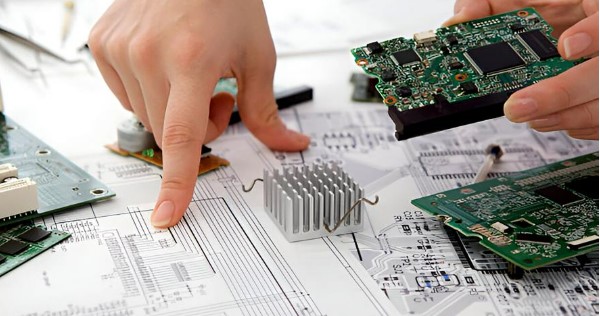As the world becomes more environmentally conscious, the electronics industry has responded with a strong push toward sustainability. One notable area of focus is the use of halogen-free materials in printed circuit boards (PCBs). In this article, we’ll explain what halogen-free PCBs are, why they matter, the standards that define them, and how trusted manufacturers like Viasion Technology support eco-friendly PCB production.
What Are Halogens and Why Are They a Concern?
Halogens are a group of chemical elements that include fluorine, chlorine, bromine, iodine, and astatine. In the PCB manufacturing process, halogenated compounds—especially brominated flame retardants (like BFRs)—are commonly used in laminate materials to improve fire resistance.
While halogens enhance safety during device operation, they pose significant environmental and health risks during production, recycling, or disposal. When burned or exposed to high temperatures, halogenated compounds release toxic gases such as dioxins and furans, which can cause respiratory problems and environmental contamination.
This growing awareness of the long-term dangers associated with halogens has led to the development and adoption of halogen-free PCB standards.
What Is a Halogen-Free PCB?
A halogen-free PCB is a circuit board made from materials that either do not contain halogens or contain them at very low levels, as defined by international standards. The goal is to eliminate or drastically reduce the presence of chlorine and bromine compounds in the PCB structure.
To be labeled as halogen-free, a material must meet specific threshold values:
- Bromine content: less than 900 parts per million (ppm)
- Chlorine content: less than 900 ppm
- Total halogen content: less than 1500 ppm
These standards are primarily based on guidelines developed by organizations such as the IEC (International Electrotechnical Commission), JPCA (Japan Printed Circuit Association), and other global regulatory bodies.
Why Are Halogen-Free PCBs Important?
- Environmental Sustainability
Halogen-free PCBs help reduce the emission of hazardous gases during manufacturing and disposal. This minimizes the impact on ecosystems and supports compliance with global environmental regulations like RoHS (Restriction of Hazardous Substances).
- Improved Workplace Safety
In manufacturing and recycling environments, halogen-free materials lower the risk of toxic exposure to workers. This contributes to safer working conditions and aligns with occupational health standards.
- Compliance with Global Regulations
Many countries and industries now require or prefer halogen-free components. Using halogen-free PCBs can make products more acceptable in international markets, especially in Europe and parts of Asia where environmental regulations are strict.
- Better Electrical Performance
In some applications, halogen-free materials offer superior thermal stability and reduced signal loss. This is especially valuable in high-speed and high-frequency circuits.
Key Standards Governing Halogen-Free PCBs
While there is no single global authority defining halogen-free standards, several widely accepted benchmarks exist:
JPCA-ES-01-2003
This standard, developed by the Japan Printed Circuit Association, is one of the most recognized benchmarks for halogen-free PCBs. It sets the maximum allowable limits for bromine, chlorine, and total halogen content.
IEC 61249-2-21
Published by the International Electrotechnical Commission, this standard defines halogen-free base materials and specifies that bromine and chlorine content must not exceed 900 ppm each, with a combined limit of 1500 ppm.
Manufacturers like Viasion Technology adhere to these and other international benchmarks to ensure that their halogen-free PCBs meet performance, safety, and regulatory requirements.
Applications of Halogen-Free PCBs
Halogen-free PCBs are now widely used in industries where safety, compliance, and environmental impact are critical concerns:
- Consumer Electronics: Smartphones, tablets, and laptops often incorporate halogen-free boards to meet environmental regulations.
- Automotive Electronics: EV systems, infotainment, and safety control units are increasingly using eco-friendly PCBs.
- Medical Devices: Reducing toxic exposure is vital in sensitive medical applications.
- Telecommunications: Network infrastructure and 5G devices benefit from halogen-free materials for high-speed signal reliability and compliance.
- Industrial Equipment: Companies committed to green manufacturing practices are transitioning to halogen-free components across their entire supply chain.
How Viasion Technology Supports Halogen-Free PCB Manufacturing
Viasion Technology, a reputable PCB manufacturer with over 16 years of experience, offers advanced solutions for halogen-free circuit board production. The company is committed to eco-conscious manufacturing practices and helps clients meet both performance goals and regulatory requirements.
Here’s how Viasion ensures quality and compliance in halogen-free PCB fabrication:
Expertise in Material Selection
Viasion Technology collaborates with world-class suppliers of halogen-free laminates, such as Shengyi, ITEQ, and Panasonic. Their engineering team helps customers choose the right base material for their design needs—balancing cost, performance, and regulatory standards.
Advanced Manufacturing Capabilities
Halogen-free materials often behave differently during fabrication. Viasion’s state-of-the-art facilities are equipped to handle these variations, ensuring precise drilling, lamination, and plating processes.
Environmental Compliance
Viasion is fully compliant with RoHS and REACH directives. Their quality management system includes material traceability, environmental audits, and documentation to support customers with green certifications.
Custom Prototyping and Production
From prototyping to low and medium-volume production, Viasion offers complete solutions tailored to your design and environmental goals. Whether you’re a startup or an established OEM, they provide scalable services with a green touch.
Final Thoughts
As the demand for eco-friendly electronics grows, understanding halogen-free PCB standards becomes essential for designers, engineers, and procurement teams. Choosing the right materials is not just about safety or compliance—it’s also about future-proofing your products in a rapidly evolving market.
Working with an experienced and reliable partner like Viasion Technology ensures that your halogen-free PCBs are manufactured to the highest standards of quality and sustainability. If your project needs to align with global environmental requirements without compromising performance, Viasion is the partner you can trust.

